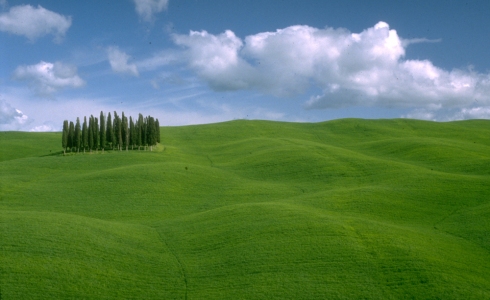



Wine: Red wine
Taste: Dry
Volume: Strong
Min. alcohol: 12%
Mandatory Storage: Min. 2 years
Storage potential: 10 years
To be confused with a great Bordeaux or a top Cabernet from California isn't the worst thing for a little, unknown wine producer to experience - and that was exactly what happened for Tenuta San Guido at the beginning of the 1970s, when the vineyard presented its first 3,000 bottles of Sassicaia from the year 1968, and again in London in 1978, at what has since been called a historic wine tasting, when the wine completely obliterated top wines from Bordeaux and other great wines with its 1972 vintage.
Since then, the wines from Tenuta San Guido have triumphed in tastings worldwide and today are viewed as the mother to all of the great Tuscan wines and the beginning of the Cabernet wines' heyday in Italy.
The confusion amongst experts at that point in time is to a degree understandable, and partially due to the grape composition, which consisted of Cabernet Sauvignon (80-100%) and Cabernet Franc (max. 20%), which were aged in barrels for two years, followed by an additional six months aging in bottles. The French connection can also be seen in the wine's interesting history.
In 1944, Baron Mario Incisca della Rocchetta planted cuttings from the Château Lafite-Rothschild on the Castiglioncello ridge - just to see how the stocks would fare in the Tyrrhenian sea air. And the start wasn't exactly promising.
The wines were rough and nearly undrinkable, but Mario still put some bottles aside that with time started to show some class. His nephew and admirer, Piero Antinori, stood on the sidelines. Together with oenologist, Giacomo Tachis, and French Emile Peynaud, Piero suggested new aging methods, and these methods would later prove to be the beginning of one of the first, and most significant, modern Italian wines aged in barriques.
Sassicaia (’sassi’ refers to the stones found in large quantities in the terrain) quickly became a cult wine and in some circles it's merely known as "Sass". A success was born, but shipments were quickly rationed. In 1983, Baron Mario Incisa died, and his son Nicoló took over management of cargo and production, which is now an average of 180,000 bottles a year.
Despite an increasing production, the wine is still being rationed to customers in both Europe and the United States, even though the vineyards' area has expanded. They are currently divided into three parcels, which altitude-wise span from 148 to 328 feet above sea level. In the lower-lying areas, the vine stocks are around 30 years old. The fields that lie over 328 feet above sea level are closed for wine cultivation due to nature conservation laws.
Sassicaia DOC has an intense, ruby red color. The aroma is elegant and complex, with notes of red fruits. The taste is powerful, concentrated and has a tremendous amount of depth with almost sweetish and balanced tannins. Once in the mouth, it becomes completely full and tight, yet at the same time still elegant. The aftertaste is lasting and with significant depth, which clearly shows that the wine has a long shelf life.
Sassicaia's quality level is very stabile, which partly is due to the very consistent coastal climate, but also due to the low harvest yield.
Fermentation is done in steel tanks with maceration of the skins for 12-15 days, followed by aging in barriques made of French or Slavic oak in air-conditioned cellars. After 5 years in the bottle, the wine develops its characteristic, spicy bouquet, together with its ample, round and smooth taste.
As recognition and a gesture from the Italian authorities, Sassicaia was granted status as an independent wine type and subzone under Bolgheri DOC in 1994.
To put it simply and with the utmost admiration: This is a great wine.
Mandatory aging: 2 years in a barrel, with an additional six months in a bottle.
That Italy in 2011 was the worlds largest wine producer?